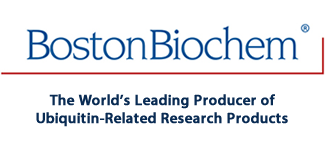
Recombinant Human His6-Josephin-1 Protein, CF Summary
Product Datasheets
Carrier Free
CF stands for Carrier Free (CF). We typically add Bovine Serum Albumin (BSA) as a carrier protein to our recombinant proteins.Adding a carrier protein enhances protein stability, increases shelf-life, and allows the recombinant protein to be stored at a more dilute concentration.The carrier free version does not contain BSA.
In general, we advise purchasing the recombinant protein with BSA for use in cell or tissue culture, or as an ELISA standard.In contrast, the carrier free protein is recommended for applications, in which the presence of BSA could interfere.
E-618
| Formulation | X mg/ml (XμM) in 50 mM HEPES pH 7.0, 300 mM NaCl, 10% (v/v) Glycerol, 1 mM DTT |
| Shipping | The product is shipped with dry ice or equivalent. Upon receipt, store it immediately at the temperature recommended below. |
| Stability & Storage: | Use a manual defrost freezer and avoid repeated freeze-thaw cycles.
|
Reconstitution Calculator
Background: Josephin-1/JOSD1
Josephin-1 is a member of the Machado-Joseph Disease (MJD) family of cysteine proteases, whose other members include Ataxin-3, Ataxin-3-like, and Josephin-2. 202 amino acids long with a predicted molecular weight of 23 kDa, Josephin-1 shares 97% identity with its mouse and rat orthologues. When ubiquitinated, Josephin-1 is capable of cleaving K48- and K63-linked polyubiquitin chains in vitro. Biologically, this enzyme may act to increase macropinocytosis and suppress clathrin- and caveolae-mediated endocytosis.
- Seki T. et al. (2013) J. Biol. Chem. 288: 17145
- Weeks S.D. et al. (2011) J. Biol. Chem. 286: 4555
FAQs
No product specific FAQs exist for this product, however you may
View all Proteins and Enzyme FAQsReviews for Recombinant Human His6-Josephin-1 Protein, CF
There are currently no reviews for this product. Be the first toreview Recombinant Human His6-Josephin-1 Protein, CF and earn rewards!
Have you used Recombinant Human His6-Josephin-1 Protein, CF?
Submit a review and receive an Amazon gift card.
$25/€18/£15/$25CAN/¥75 Yuan/¥1250 Yen for a review with an image
$10/€7/£6/$10 CAD/¥70 Yuan/¥1110 Yen for a review without an image
ebiomall.com






>
>
>
>
>
>
>
>
>
>
>
碳酸氢钠溶液是一种co2缓冲液,当瓶内二氧化碳量减少时,碳酸氢钠溶液释放co2,反之吸收co2.因此它能保持瓶内二氧化碳量大致不变.
血清的基本成分是水,水中溶有蛋白质、脂肪、糖、无机盐、维生素等营养成分,也溶有人体代谢产物。血清中有抗体,这是被称作免疫球蛋白的蛋白质。
你说的应该称抗毒血清。
因制作时是将蛇毒、病原菌产的毒等小量多次地注射到免子、马血管内,每日慢慢加大注射量,一定时间后,因该动物体内产生抗体,经检测,达到一定效价后,就可以抽血。血液分离血清后再经提纯,就成了抗毒血清。
如蛇、白喉、破伤风、狂犬病抗毒血清等都是如此制备,用来治疗相应毒素反应。
该生物制剂是异种血清,对人会有过敏反应,注射前均要做皮试。阴性可注射,阳性必需作脱敏疗法才行。
当抗体结合到示踪剂上时,340nm的激发光激发铕标分子,导致能量转移到Alexa Fluor 647染料上,结果产生665nm的发射光。荧光的强度与样品中的cAMP含量成反比。
本试剂盒用于检测在GPCR激动剂刺激下活细胞或者细胞膜制备品产生的cAMP。对于偶联Gαs的受体,激动剂刺激导致665nm的荧光强度降低,而拮抗剂则可以逆转这一效应;对于偶联Gαi的受体,在激动剂刺激的同时用forskolin刺激cAMP产生,那么激动剂则抑制forskolin诱导的cAMP的生成,因此对照只给forskolin的细胞组可以通过665nm荧光强度的增加反应激动剂的效应。
该试剂盒的灵敏度很高,室温下反应在20h内是稳定的。本试剂盒适用于在384孔板中进行24μl的微量分析。
2.保存条件
避光2~4℃保存,过期时间见装。
3.盒内试剂
cAMP标准品:1管,1ml。(50μM)
生物素标记的cAMP(b-cAMP):1管,25μl。
铕标的抗生物素蛋白链菌素:1管,25μl。
荧光标记的cAMP抗体:1管,40μl。
检测缓冲液:1瓶,25ml。
4.需要自配的其他溶液
l Hank’s balanced salt solution (HBSS): NaCl 8.0g、CaCl2 0.14g、KCl 0.4g、 KH2PO4 0.06g、Na2HPO4?7H2O0.09g、MgCl2.6H2O0.10 g、MgSO4.7H2O0.10 g、NaHCO30.35g、葡萄糖1.0g,加H2O至 1000ml (用7.5%NaHCO调节PH值=7.4)
l Versene消化液(1L):EDTA 0.372 g,NaCl 8.0g,KCl 0.20 g,KH2PO40.20g,Na2HPO4 1.15 g,D-glucouse 0.2 g,pH 7.4
l HEPES缓冲液(1mol/L):取2.383gHEPES溶于10ml去离子水中。
l 7.5%BSA溶液:取0.75gBSA溶于10ml去离子水中
l 0.5M IBMX溶液:11.11mg IBMX溶于100μl DMSO中,-20℃冻存。
l 刺激缓冲液(SB):14 ml HBSS(1×)+75μlHEPES(1mol/L)+200μlBSA (7.5%)。(注:在测定细胞cAMP时,反应缓冲液中要加入IBMX 0.5mmol/L)
l 吗啡贮存液(10mM):盐酸吗啡37.585mg溶于10ml生理盐水中,0.22μm滤膜过滤除菌,4℃保存备用。
l 纳络酮母液(100mM):纳络酮4mg溶于100μl 生理盐水中,用时工作液按照1:500稀释,溶剂为含有IBMX的反应缓冲液。
1)提供基本营养物质:氨基酸、维生素、无机物、脂类物质、核酸衍生物等,是细胞生长必须的物质。
2)提供结合蛋白:结合蛋白作用是携带重要地低分子量物质,如白蛋白携带维生素、脂肪、以及激素等,转铁蛋白携带铁。结合蛋白在细胞代谢过程中起重要作用。
3)提供激素和各种生长因子:胰岛素、肾上腺皮质激素(氢化可的松、地塞米松)、类固醇激素(雌二醇、睾酮、孕酮)等。生长因子如成纤维细胞生长因子、表皮生长因子、血小板生长因子等。
4)对培养中的细胞起到某些保护作用:有一些细胞,如内皮细胞、骨髓样细胞可以释放蛋白酶,血清中含有抗蛋白酶成分,起到中和作用。这种作用是偶然发现的,现在则有目的的使用血清来终止胰蛋白酶的消化作用。因为胰蛋白酶已经被广泛用于贴壁细胞的消化传代。血清蛋白形成了血清的粘度,可以保护细胞免受机械损伤,特别是在悬浮培养搅拌时,粘度起到重要作用。血清还含有一些微量元素和离子,他们在代谢解毒中起重要作用,如SeO3,硒等
5)提供促接触和伸展因子使细胞贴壁免受机械损伤。
6)血清中有抗体,这是被称作免疫球蛋白的蛋白质,血清可以抗病毒,增强抵抗力血清属于生物制剂。
急求日本《医药品添加物事项》中有关“十六醇”的资料,请各位大神帮帮忙









